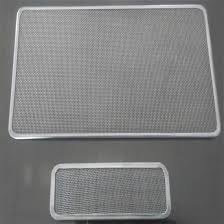
Filtration is the most important application for woven wire meshes. Filter meshes and mesh combinations are the outcome of extreme research and experience of innumerable applications in diverse industrial sectors. Our best filtration results can be attained by achieving the suitable balance between different elements, premium quality materials, stainless steel, flawless meshes and extensive understanding of filtration processing in the various applications.
By using woven nickel wire mesh screens it is ensured that you will receive secure and economical filtration results. Considering the initial flow of gases and liquids containing solids, the screens separate the particles larger than holes from the solid containing gases or liquids. These are captured on the mesh surface and with time, build up a filter cake which works as a further filtration medium. The filtrate is removed when it becomes too thick or too compacted. Accurate pore distribution results in regular build up of filter cake, and the smooth surface of mesh offers good cake release and backwashing.
Essential factors to be considered while choosing the screens for filtration process:
Material, loading during process, pressure ratio, mass shape.
Determining geometric pore size is based on weaving factors like type of weave, warp and weft diameters and mesh count. The geometric pore size states the diameter of the largest sphere passing through the weave.
The underlying equations to state the geometric pore size were evaluated and tested in lab conditions. The mesh fineness or pore size is an essential characteristic of filter mesh. Nowadays, this term is mainly used to state the absolute filter fineness. This states the diameter of the largest solid spherical particle which can flow through the filter medium under static flow conditions.
For monofilaments, twilled dutch mesh weave produces small pores and smooth mesh surface whilst the larger material cross section offers higher levels of mesh stability. When passing through a twilled dutch mesh, particles should follow five offset pore levels. It states that oblong, thin and fibrous particles are safely held. Fine specification twilled mesh screens are used for fine filtration like pressure filtration in hydraulic steering equipment and fuel filters for critical applications. Coarser specification twilled dutch meshes are used for pressure and vacuum filtration and hence porous medium for fluidized bed applications. These screens are usually produced from stainless steel.
Plain dutch weave mesh has a slightly textured surface and is mainly used to handle high flow rates and offers low pressure loss. This weave type is commonly used where mechanical loading is high for example for settling filters and filter candles, well filters and vacuum filters. Heanjia supplies mesh screens which are made of durable and corrosion resistant materials. These screens offer long life and can be produced in a wide range of specifications to serve your needs. Contact us today to discuss your application requirements and order a mesh. We will be happy to assist you.


